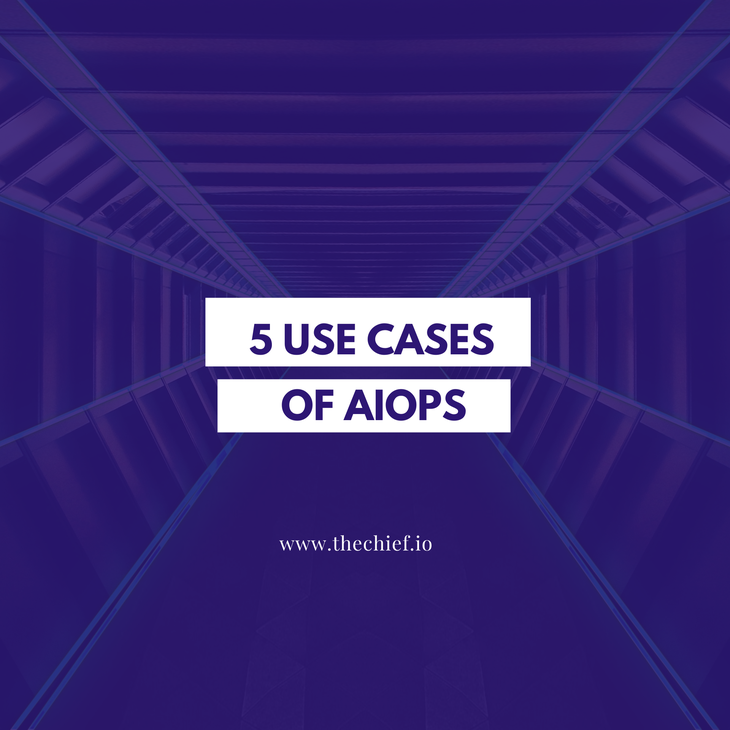5 Use Cases of AIOps
in AIOps

Adopting AIOps solutions and choosing the right tool can be a game-changing decision for small and large organizations as the advantages are enormous. It reduces the workload on IT teams, increases their productivity, and makes your application faster, more innovative, efficient, and reliable.
Today, many companies are transitioning from traditional on-premise infrastructure to a dynamic and hybrid mix of on-premise, private and public cloud environment which runs on various software that allows it to scale based on demands. Applications across this environment generate quintillions of data that keep growing.
Traditional IT management solutions cannot keep up with correlating and organizing this growing amount of data and often leaves IT operators, with a load of issues that leads to application inefficiency and, ultimately, downtime. Here is where AIOps comes into the picture.
What is AIOps?
AIOps meaning, “Artificial Intelligence for IT Operations,” is a word coined by Gartner - an industry-leading software and IT research firm. To name the practice of using artificial intelligence (AI), Big Data analysis, and machine learning (ML) to deliver easy management and resolution of crucial IT operation problems.
AIOps provides real-time monitoring and visibility into data and dependencies across the application environment, analyzes the events, and automatically presents IT operators the issues, root causes, and recommends solutions based on previously learned data.
One common question companies ask when they hear of AIOps is, “why do we need AIOps?”
The answer is not far-fetched. Using AI-driven tools in IT operations can significantly increase the efficiency of cloud applications and service and IT and DevOps teams' productivity.
We wrote a full detailed article on why you need AIOps as an organization and another on what you need to consider before adopting AIOps.
To the title of this article, there are a handful of use cases where AIOps can be applied to IT operation to maximize productivity; some of these include;
- IT noise reduction
- Anomaly detection
- Root cause analysis
- Event correlation
- Automated remediation
Let's take a closer look into each of them below, and see how AIOps applies to each situation to make the tasks on operation teams less overwhelming.
IT Noise Reduction
Often referred to as an enemy of productivity, modern systems' increasing complexity generates more IT noise. By “IT noise," we mean false or unnecessary alerts and notifications that hinder IT professionals, from figuring out the real issue with the system and resulting in a waste of time and resources.
The large volume of data in modern IT environments generates many false positives (when there’s no issue in the system but your alerting tool generates false alarms). False negatives (when there is a severe issue in your system but your alerting device does not recognize or report the problem), this is referred to as IT noise. This often results in the IT operators ignoring the alerting system. In the case of false negatives, it makes the IT team unaware of serious issues that may escalate to costly system downtimes.
This is where AIOps comes into play. Artificial intelligence and machine learning algorithms solve this problem by automatically collecting and correlating, and calculating alerts across the application stacks. This ensures that only data that IT teams can leverage to identify root causes of anomalies are alerted, saving them time and energy used in manual analysis.
Predictive Analysis and Anomaly Detection
DevOps teams often detect faults and anomalies in their infrastructure when a user reports a horrible service experience. This requires them to quickly identify the problem, find and fix the bug manually. But with the complex data systems in modern systems, the task gets too complicated and less effective.
AIOps tools leverage artificial intelligence, machine learning, and deep learning to compare real-time performance metrics with past analytics to identify anomalies. AIOps pattern detection functionality allows setting predefined performance baselines, which, when the comparison of the past and present performance ranges across it, the tool automatically generates alarms.
This will enable IT and DevOps teams to be more proactive in addressing and solving critical issues before affecting the services, leading to greater user satisfaction.
Many AIOps tools automatically create a ticket that includes all details required to resolve the issue when a fault is detected.
Root cause Analysis
Rather than just solving it on the surface, it is important to find what the underlying cause of an issue is in the first place.
The complexity in modern systems makes it tedious and time-consuming to analyze large volumes of data and alerts to find the root cause of anomalies.
In addition to detecting anomalies, AIOps has the capability to collect and correlate events then use machine learning inference models in segregating related events to identify the root cause of issues.
This in-depth diagnosis of the primary cause of issues helps IT teams respond and resolve problems quickly and efficiently.
Event correlation and Intelligent Alerting
IT management tools alert a lot of events yet there is only a handful that really matters.
According to an AIOps exchange report, 40% of companies get over 1 million incident alerts in a day. That results in alert fatigue, which could lead IT professionals, to ignoring critical warnings that may cause system downtime.
AIOps collects these alerts, analyzes them to find relationships between the data, and groups them into a smaller number of notifications, ensuring only issues with high business value are alerted.
AIOps also uses artificial intelligence to notify experts of subject incidents for a faster resolution.
Automation
Operations teams resort to adopting manual processes and different tools to resolve the large volume of alerts generated by their system. They perform this process over and over again as the data grows even more extensive. This manual process is tedious and increases outages and downtime, costing the valuable company dollars.
AIOps uses machine learning algorithms to streamline, correlate, detect, route, resolve and automate various aspects of the incident management lifecycle.
AI-powered solutions also automate the remediation of known issues. IT learns from past issues and their resolution and suggests the best approach to resolve identified problems.
These enable IT operators to handle incident alerts and, as a result, improve application performance and availability and reduce outages and downtime.
Get similar stories in your inbox weekly, for free
Share this story:

The Chief I/O
The team behind this website. We help IT leaders, decision-makers and IT professionals understand topics like Distributed Computing, AIOps & Cloud Native
Latest stories
HIPAA and PCI DSS Hosting for SMBs: How to Choose the Right Provider
HIPAA protects patient data; PCI DSS protects payment data. Many small and mid-sized businesses now …
The Rise of GPUOps: Where Infrastructure Meets Thermodynamics
GPUs used to be a line item. Now they're the heartbeat of modern infrastructure.
Top Bare-Metal Hosting Providers in the USA
In a cloud-first world, certain workloads still require full control over hardware. High-performance computing, latency-sensitive …
Top 8 Cloud GPU Providers for AI and Machine Learning
As AI and machine learning workloads grow in complexity and scale, the need for powerful, …
How ManageEngine Applications Manager Can Help Overcome Challenges In Kubernetes Monitoring
We tested ManageEngine Applications Manager to monitor different Kubernetes clusters. This post shares our review …
AIOps with Site24x7: Maximizing Efficiency at an Affordable Cost
In this post we'll dive deep into integrating AIOps in your business suing Site24x7 to …
A Review of Zoho ManageEngine
Zoho Corp., formerly known as AdventNet Inc., has established itself as a major player in …
Should I learn Java in 2023? A Practical Guide
Java is one of the most widely used programming languages in the world. It has …
The fastest way to ramp up on DevOps
You probably have been thinking of moving to DevOps or learning DevOps as a beginner. …
Why You Need a Blockchain Node Provider
In this article, we briefly cover the concept of blockchain nodes provider and explain why …
Top 5 Virtual desktop Provides in 2022
Here are the top 5 virtual desktop providers who offer a range of benefits such …











